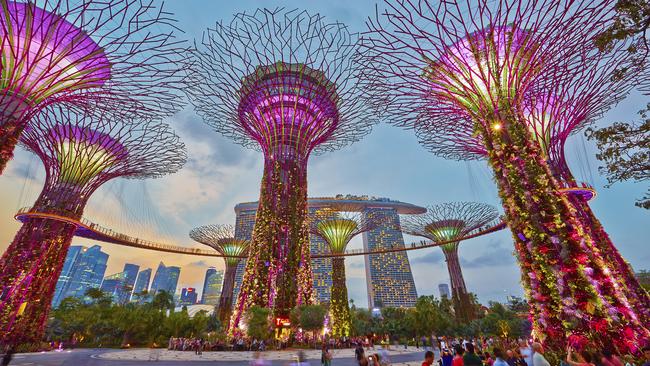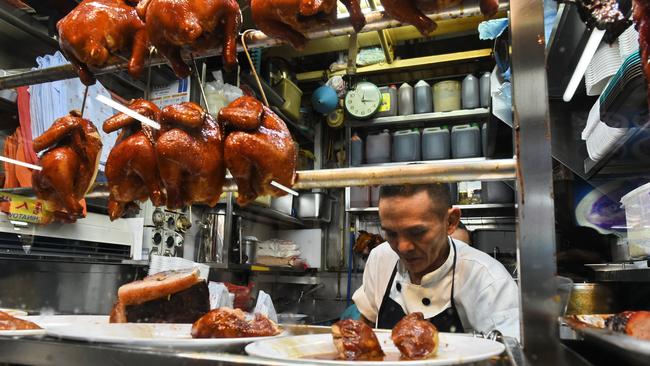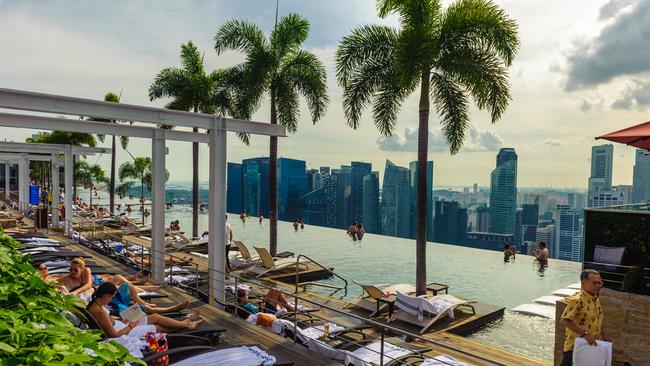Singapore’s top 10 attractions, from WWII history to fine dining
Enjoy gin slings and Michelin meals in a metropolis on the move.

Enjoy gin slings and Michelin meals in a metropolis on the move.
1. FIRST UP: Singapore’s international gateways are reliable guides to what lies ahead in the island city-state. Changi Airport has been judged the world’s best; it’s efficient and totally mindful of travellers’ needs. Likewise, Singapore Cruise Centre and the newer Marina Bay Cruise Centre offer a smooth, warm welcome and are helping the city take the lead in a booming passenger-ship market. Singapore, which has grown by a quarter in the past 50 years thanks to land reclamation, has a dramatic skyline, is safe, clean and so easy to negotiate (even the Singapore and Aussie dollars are pretty well at parity, ruling out those complicated conversions). There’s no graffiti or chewing gum, and expressways lined with tropical vegetation hide the unsightly. Too regulated, not “authentic” enough? Maybe, but there’s still rough and tumble in colourful districts such as Chinatown and Little India. Singapore sits just north of the equator, so on any visit it will be hot and humid. Be modest with outdoor walking expectations and master the extensive public transport system with a Singapore Tourist Pass or hop in a cab (inexpensive and delicious air-con always on). I have a guide, Jane, who is informed and irreverently witty, to show me the sights.
More: yoursingapore.com
2. ART WITH A PAST: No two ways about it, National Gallery Singapore is a must do. Just over a year old, it occupies two colonial buildings, the former Supreme Court (1939) and City Hall (1929), now linked by a dramatic glass atrium. Historic spaces have been preserved — courtrooms, detention cells, the chamber in which the Japanese surrendered in 1945 and Lee Kuan Yew was sworn into office heading the first government after independence from Britain. But the focus is on the fabulous galleries and an 8000-work collection of Singaporean and Southeast Asian art, from traditional to contemporary. Until March 26, see the exhibition Artist and Empire: (En)countering Colonial Legacies, combining works from Tate Britain and regional collections. Linger in the gallery, which has diverse dining options (including upmarket Odette), regular concerts, talks and children’s activities. The view from the rooftop is sensational, taking in the sweep of the ceremonial Padang, with Singapore Cricket Club at one end and Singapore Recreation Club at the other.
More: nationalgallery.sg.

3. WELCOME HOME: Alvin Yapp is an enthusiast. In his home-cum-museum in the neighbourhood of Joo Chiat, Alvin leads us on a lively exploration of Peranakan culture and his valued collection of furniture, ornaments, porcelain, fabrics, beaded shoes, jewellery, costumes, letters, photographs; mind the jars as you climb the narrow staircase. Peranakans are the descendants of Chinese who settled in the Malay archipelago. Mostly males (who left wives in China), they married Malay women and during British rule took on very English ways. The Intan (meaning rose-cut diamond), as Alvin’s museum is known, displays sideboards that would enhance any stately home, decorated with an explosion of Chinese figures. His mum has been preparing afternoon tea with delicious Peranakan sweet treats. And then Alvin, by request, takes to his piano and plays Waltzing Matilda and Somewhere Over the Rainbow. Wacky, but so entertaining. Admission is by appointment.
More: contactus@the-intan.com.
4. LONG SHOT: Raffles Hotel, the grand property dating from 1887 (you know, Rudyard Kipling, Somerset Maugham, Noel Coward, Liz Taylor, William and Kate, that lot), will be closed in phases from mid-year for a refurbishment and, in any case, the lobby is generally open to guests only. We pass the busy Tiffin Room, where High Tea is being served, on the way to the Long Bar, where just over 100 years ago bar captain Ngiam Tong Boon concocted the Singapore Sling. It’s time for a masterclass in making the pink cocktail — Gordon’s gin, Dom Benedictine, Cointreau, Heering cherry liqueur, pineapple juice and much else are lined up, but it comes at the end of a long day so my ingredient measurements are erring on the side of “let’s go for it”. The pineapple and cherry wedge should sit just-so on the shoulder of a character etched on the tall serving glass; well slung as it were. I get this bit right and love my unique mix, accompanied by satays. Back to my hotel for a snooze. Slings will be served in the Bar and Billiard Room while the Long Bar is being refurbished. Masterclasses are offered in groups.
More: raffles.com.
5. THE BEST FOR LESS: There can be few Michelin-starred places on Earth where a meal leaves you with change from $10; two are in Singapore. At Hill Street Tai Hwa Pork Noodle (actually located at 466 Crawford Lane #01-12) the signature dish is bak chor mee (noodles, tossed through black vinegar, with minced pork and liver slices). Owner chef Tang Chay Seng is in the kitchen on a Sunday morning, continuing the tradition dating from his father’s street stall in the 1930s. Not far away in the Chinatown Complex, the Liao Fan Hong Kong Soya Sauce Chicken Rice & Noodle stall is serving up, well, what its name states. Chef Chan Hon Meng has opened a new restaurant, Hawker Chan, with kindred menu at 78 Smith Street (once a notorious red-light thoroughfare, now the heart of bustling Chinatown) and he too is in the kitchen on a Sunday. The catch is that long queues form for these outlets. For a quicker bite, Singapore has about 6000 street food stalls, often in purpose-built hawker centres, with hygiene standards strictly enforced.
More: yoursingapore.com.

6. TOP TABLES: Of celebrity chefs, Singapore has quite a few bolstering its reputation for international fine dining — think Joel Robuchon, Wolfgang Puck and Aussies Tetsuya Wakuda and Luke Mangan. But Singaporean Ignatius Chan has led his restaurant Iggy’s to a regular spot on The World’s 50 Best Restaurants list in recent years (No 18 in 2016; the 2017 awards take pace in Melbourne on April 5). Located in the Hilton Hotel on always-classy Orchard Road, Iggy’s is an intimate dining room and the perfect spot for culinary theatre; at one point a window lights up revealing the kitchen and its masterful staff at work. Chan explains each dish on a tasting menu, with produce from Europe, Japan and Australia, and paired wine. Yes, please, to Cheeky Sir, a delectable cut of beef with green asparagus and pearl onion. But rarely have I been in a more beautiful dining space than The Clifford Pier, part of The Fullerton Bay Hotel. Once an immigrant arrivals terminal, the 1933 pier has a roof structure of giant arched trusses. Repurposed as a restaurant (land reclamation puts it kilometres away now from where a big ship could dock), it is decorated during my visit for Chinese New Year with red lanterns and vibrant floral arrangements. Add a glamorous chanteuse and an exotic menu (fried carrot cake with sweet soy prawns) and you’ve got a magic night out.
More: iggys.com.sg

7. STORY OF THE FALL: Embedded in Fort Canning Hill, not far from Orchard Road, lies the Battlebox, part of the Malaya Command that defended Malaya and Singapore in World War II. In the small rooms of this bunker complex the decision was made to surrender to the Japanese on February 15, 1942. On The Battlebox Experience: A Story of Strategy and Surrender tour, guide Eisen vividly relates how British Lt-Gen Arthur Percival and his command team, including Australian Lt-Gen Gordon Bennett, made the decision (not without tense disagreement) to fly the white flag. After 70 days of brutal fighting along the Malay Peninsula and woeful naval and army back-up, the Fall of Singapore was inevitable. Films, photographs and displays recreate how difficult it must have been living and working in this claustrophobic subterranean environment. Tours can also be made of Changi Museum and historical site, relating the brutal history of the POW camp.
More: battlebox.com.sg
8. GREEN AND GRAND: The view from my hotel balcony (see Best Beds) is over a wonderland of vegetation, superstructure conservatories and a grove of gigantic sculptured “trees” (atmospherically lit by night), bordering Singapore Strait, where hundreds of vessels are lined up to enter the port. Gardens by the Bay, on 101ha of reclaimed land, is a significant greening project that has been winning environmental and architectural awards since 2012. One of the cool (as in, spend hours here away from the heat) conservatories is a Flower Dome, with changing themed displays (Christmas was being bumped out on my visit; Chinese New Year arriving); the other a Cloud Forest. In the latter, take the lift to the peak of a “mountain”, then wind down a walkway past orchids, ferns and a 35m waterfall. Guide Jane is delighted to point out a Wollemi pine, propagated from the ancient trees discovered northwest of Sydney 22 years ago. On to the Supertrees with their vertical plant displays; get a bird’s-eye view from a 22m-high skyway and stay for the sound and light show after dark.
More: gardensbythebay.com.sg.
9. A BRIDGE NOT TOO FAR: Crossing over to Sentosa Island, just off Singapore’s south coast, feels like a quick nip to a tropical resort destination, all palm trees, flower-filled roundabouts, a long and sheltered beach, and peacocks roaming clipped gardens. Progress by taxi, a combo of MRT subway and monorail, or cable-car; once on the island, shuttle transport by bus or tram is free and, this being Singapore, punctual and efficient. Resorts World, which includes Universal Studios, keeps kids nicely entertained; Fort Siloso’s restored gun battery and war museum is open to the public. There are two golf courses and at least a dozen hotels of which the Sofitel Sentosa Resort and Spa especially shines with its clifftop position, beach cove, stand-alone spa village and the prospect of green-tea eclairs for afternoon tea and snazzy Sentosa Slings at Le Bar.
More: sofitel-singapore-sentosa.com.
SUSAN KUROSAWA
10. THE HIGH LIFE: Marina Bay Sands, with more than 2500 guestrooms and suites, is big and bold, and comes with its own destination map. It’s a landmark on Singapore’s modern skyline with three towers joined by a ship-shaped rooftop structure; think a gigantic Stonehenge remnant or mathematical symbol. My guestroom is comfortable and spacious, with sleep-assured bed, day lounge positioned to take in the view and even a welcoming towel-art puppy. On the rooftop, an infinity pool falls away to the city behind (pictured); it’s wonderful but not relaxed as guests crowd the water taking selfies. On this level, dine with a view at Spago by Wolfgang Puck or Sky on 57. The hotel also has a Banyan Tree Spa, a casino (with entry fee for Singaporeans to discourage gambling), Expo and Convention Centre and lotus-shaped ArtScience Museum. Then there are The Shoppes: wall-to-wall celebrity-chef dining (including Tetsuya’s Waku Ghin) and luxury-brand stores, open helpfully late. Don’t be daunted, though; a food court is dumpling heaven and, in a blast from the past, there’s even a CD store.
More: marinabaysands.com.

Graham Erbacher was a guest of the Singapore Tourism Board.



To join the conversation, please log in. Don't have an account? Register
Join the conversation, you are commenting as Logout